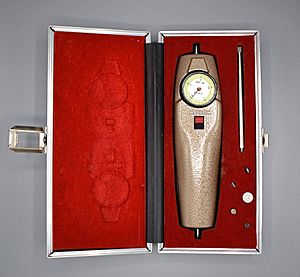Transducer facts for kids
A transducer is a cool device that changes energy from one form into another. Think of it like a translator for energy! Usually, a transducer takes a signal in one type of energy and turns it into a signal in a different type.
These devices are super important in things like automation, measurement, and control systems. They help convert electrical signals into other physical things, like light, motion, or even how much force something has. The whole process of changing energy from one form to another is called transduction.
Contents
Different Kinds of Transducers
Some transducers change physical things (like temperature or pressure) into mechanical movement or force. These are called mechanical transducers.
Other transducers change physical things into electrical signals. These are known as electrical transducers. For example, a thermocouple is a type of electrical transducer. It can sense a difference in temperature and turn it into a tiny electrical voltage. Another example is a linear variable differential transformer (LVDT), which measures how much something moves.
Sensors and Actuators: What's the Difference?
Transducers can also be grouped by which way the information flows through them:
- A sensor is a transducer that takes in information or a signal from the world around it. It then creates a signal that tells us something about that information. This signal can be used by a control system or to send data.
- An actuator is a device that makes something move or controls a system. It gets a signal from a control system or a person. The actuator then uses energy (like electricity or air pressure) to create motion. It's how a control system actually does something in the real world.
Some transducers can work both ways! They can change physical things into electrical signals and also change electrical signals back into physical things.
- A great example is an antenna. It can turn radio waves into an electrical signal for your radio to pick up. It can also take an electrical signal from a transmitter and turn it into radio waves to send out.
- Another example is the voice coils found in loudspeakers. They turn an electrical audio signal into sound you can hear. In a dynamic microphone, they do the opposite: they turn sound waves into an electrical audio signal.
Active vs. Passive Sensors
Sensors can also be divided into two main types:
- Active sensors need an outside power source to work. This power source sends out a signal, which the sensor then changes to create its output. For instance, a thermistor doesn't make its own electricity. But if you send an electric current through it, you can measure its resistance to figure out the temperature.
- Passive sensors, on the other hand, create their own electrical signal when they sense something, without needing extra power. Examples include a photodiode (which reacts to light), a piezoelectric sensor (which reacts to pressure or vibration), and a thermocouple (which reacts to temperature).
How Transducers Work: Key Features
When we talk about how good a transducer is, we look at a few things:
- Dynamic range: This is the difference between the biggest signal and the smallest signal a transducer can handle well. Transducers with a bigger dynamic range are usually more accurate and sensitive.
- Repeatability: This means how well a transducer can give the exact same output every time it gets the exact same input. It's about being consistent.
- Noise: All transducers add a little bit of random "noise" to their output. For electrical transducers, this can be tiny electrical disturbances. Noise can make it harder to detect very small signals.
- Hysteresis: This is when the transducer's output depends not just on what's happening right now, but also on what happened before. For example, if an actuator (a type of transducer) changes direction, there might be a small delay or "dead zone" before it starts moving the other way.
Where Are Transducers Used?

Transducers are used everywhere! Here are some cool examples:
- Electromagnetic Transducers: These deal with electricity and magnetism.
- Antennae: Change radio waves into electrical signals and vice versa.
- Hall effect sensors: Measure magnetic fields and turn them into electrical signals.
- Electromechanical Transducers: These change electrical signals into mechanical motion or force. Many of these are called actuators.
- Accelerometers: Measure how fast something is speeding up or slowing down.
- Rotary motors: Turn electricity into spinning motion.
- Load cells: Measure force or weight and turn it into an electrical signal.
- Pressure sensors: Measure pressure and turn it into an electrical signal.
- Electroacoustic Transducers: These work with sound and electricity.
- Loudspeakers and earphones: Turn electrical signals into sound.
- Microphones: Turn sound into electrical signals.
- Piezoelectric crystals: Change vibrations into electrical signals, and electrical signals into vibrations.
- Hydrophones: Sense changes in water pressure and turn them into electrical signals.
- Electro-optical Transducers: These deal with light and electricity.
- Light-emitting diodes (LEDs): Turn electrical power into light.
- Photodiodes: Sense changing light levels and turn them into electrical signals.
- Cathode-ray tubes (CRTs): Turn electrical signals into images you can see (like old TV screens).
- Thermoelectric Transducers: These work with heat and electricity.
- Resistance temperature detectors (RTDs): Change temperature into an electrical resistance signal.
- Thermocouples: Measure temperature differences and turn them into electrical voltage.
- Thermistors: Their electrical resistance changes with temperature, allowing us to measure it.
See also
 In Spanish: Transductor para niños
In Spanish: Transductor para niños


